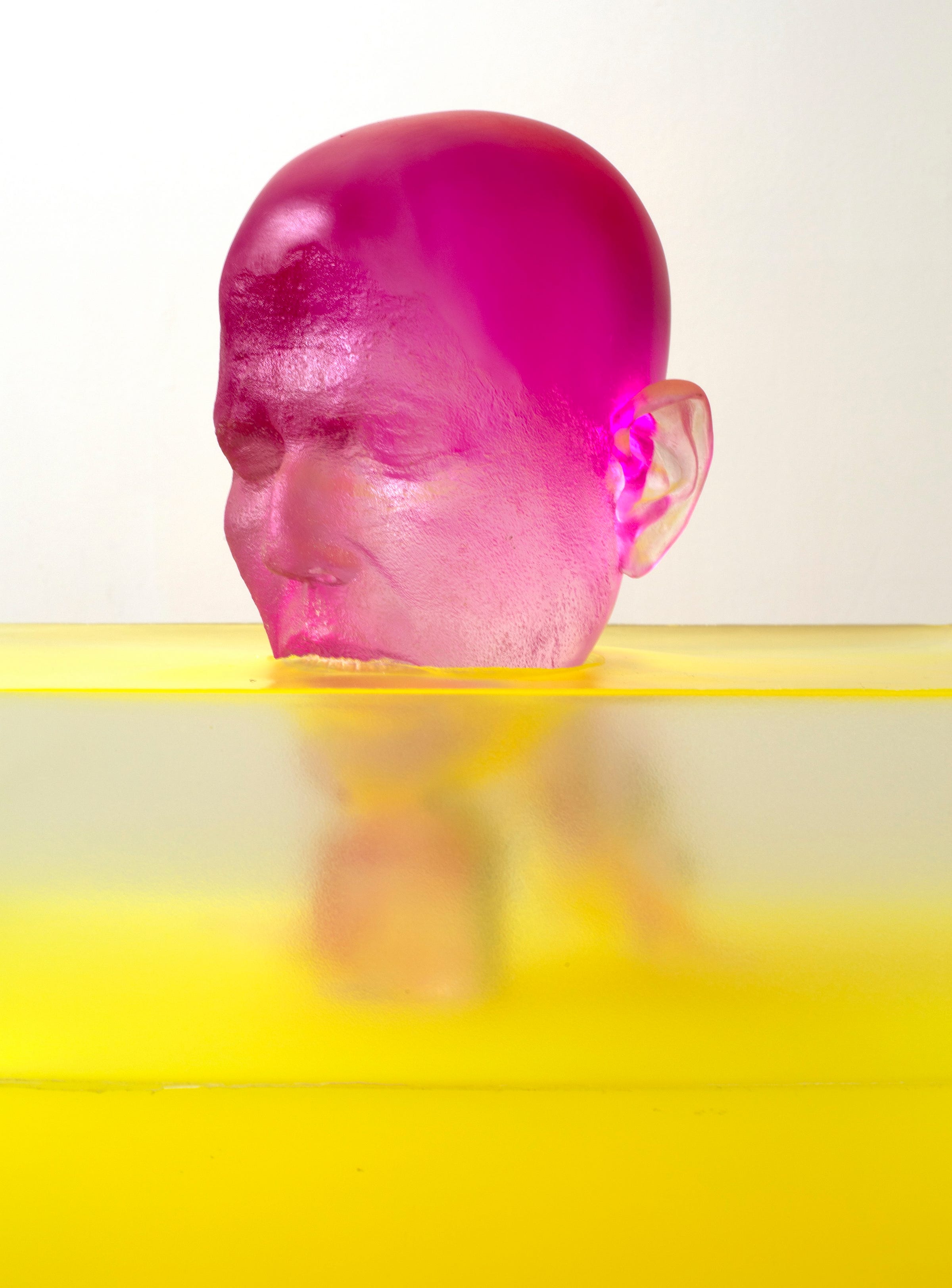
In this edition, I am celebrating the “Anonymous Was A Woman” Award, some of its recipients, and the exhibition Anonymous Was A Woman: The First 25 Years currently open at the Grey Art Museum at New York University. The exhibition was curated by Nancy Princenthal and Vesela Sretenović who chose works that demonstrate the breadth of themes, materials, and techniques used by artists since 1996. Other works were chosen for the way they reflect the position of women artists in society and explore issues of identity and anonymity.
AWAW has given me an immense amount of joy—and mostly since I’ve gone public. It’s a way to show my activism and advocate that women shouldn’t remain anonymous any longer. – Susan Unterberg
The Anonymous Was A Woman (AWAW) award program was begun, anonymously, in 1996, in response to the decision of the National Endowment for the Arts to cease making grants to individual artists. The name was inspired by a line from A Room of One’s Own by Virginia Woolf and it honors the many women artists throughout history who have been, and in many cases remain, anonymous. In 2018, the founder and original funder of AWAW revealed herself. Susan Unterberg (American, b. 1941), a photographer, had experienced first-hand the challenges of being an artist and a woman. She had remained anonymous to avoid having her own work judged for her philanthropy rather than on its merits. She came forward because she wanted to further the organization’s cause and encourage others to support it.
Awards are made to woman-identifying artists over the age of 40, who work at least part-time in the United States. The goal of the program is to support the artists in continuing to develop their careers and pursue their work. Candidates are nominated anonymously by prominent women in the arts – historians, curators, writers, and former award recipients. Since its founding, over $6.5 million has been awarded to more than 300 hundred artists.
When I received my AWAW award, the overwhelming feeling was one of “My God, someone is actually paying attention.” – Nina Katchadourian (American, b. 1968), award year 2003
In this limited space, I can share works by a very small number of the recipients, which I have chosen from the artists included in the Grey Museum exhibition. Three AWAW award recipients have been presented here on the I Require Art Substack in the past: Mickalene Thomas, award year 2013 (Viewing Room 27); Simone Leigh, award year 2016 (Chance Encounters 41); and Judithe Hernández, award year 2021 (Chance Encounters 37).
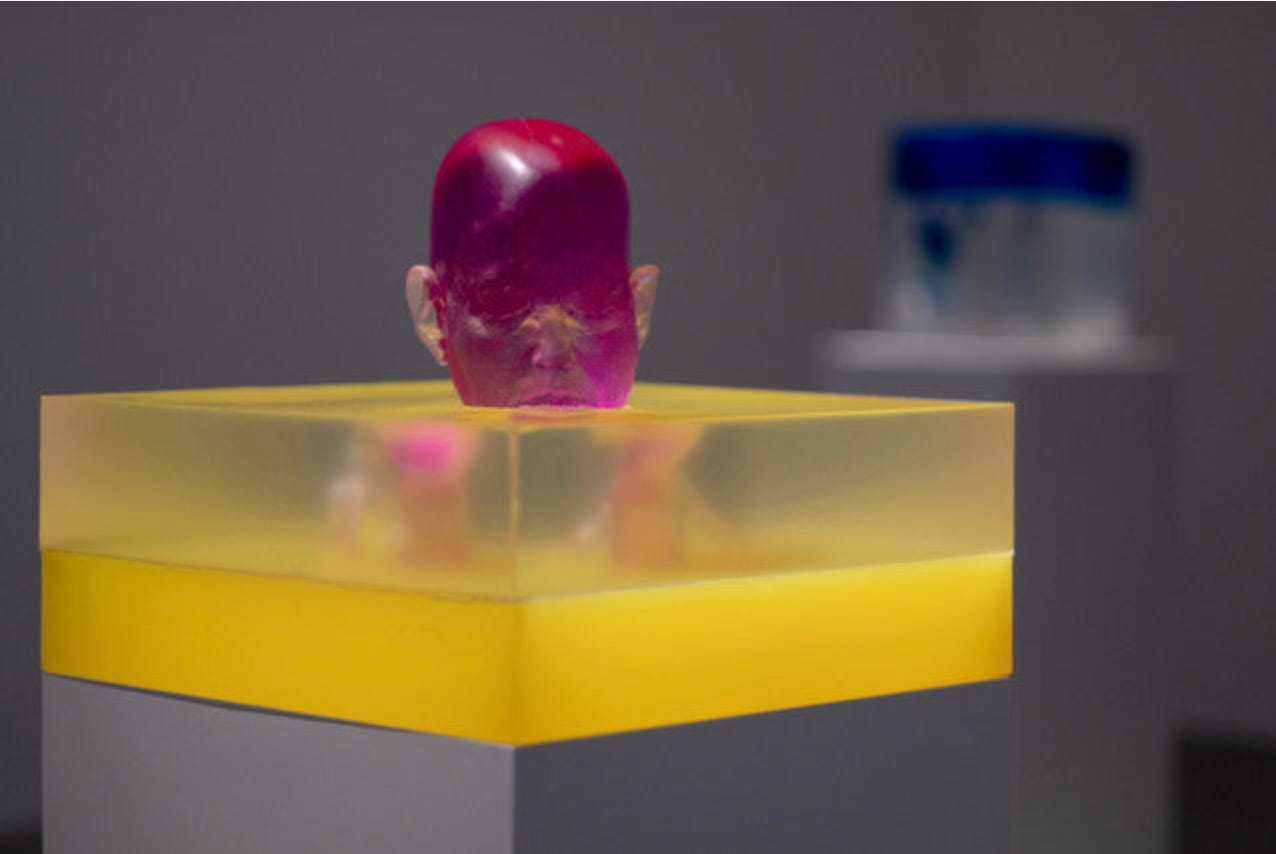
Rona Pondick (American, b. 1952) creates sculptures in a wide variety of materials, often using traditional casting techniques, with both traditional and innovative materials. Many of the artist’s works depict human-animal hybrid figures. In Magenta Swimming in Yellow (2015-2017), a tiny body supports the head, but the body’s presence is obscured by its cloudy yellow surroundings. The strangeness of this work is intensified by the use of translucent resin and acrylic and by the vividly saturated color. Pondick uses her own body as a model but her materials tend to anonymize the body parts. The body parts in her sculptures all derive from a single scan and cast made from her own body in 1998, but she doesn’t consider any of her pieces self-portraits. Instead, the artist regards her body as a tool like any other that she uses to create her sculptures.
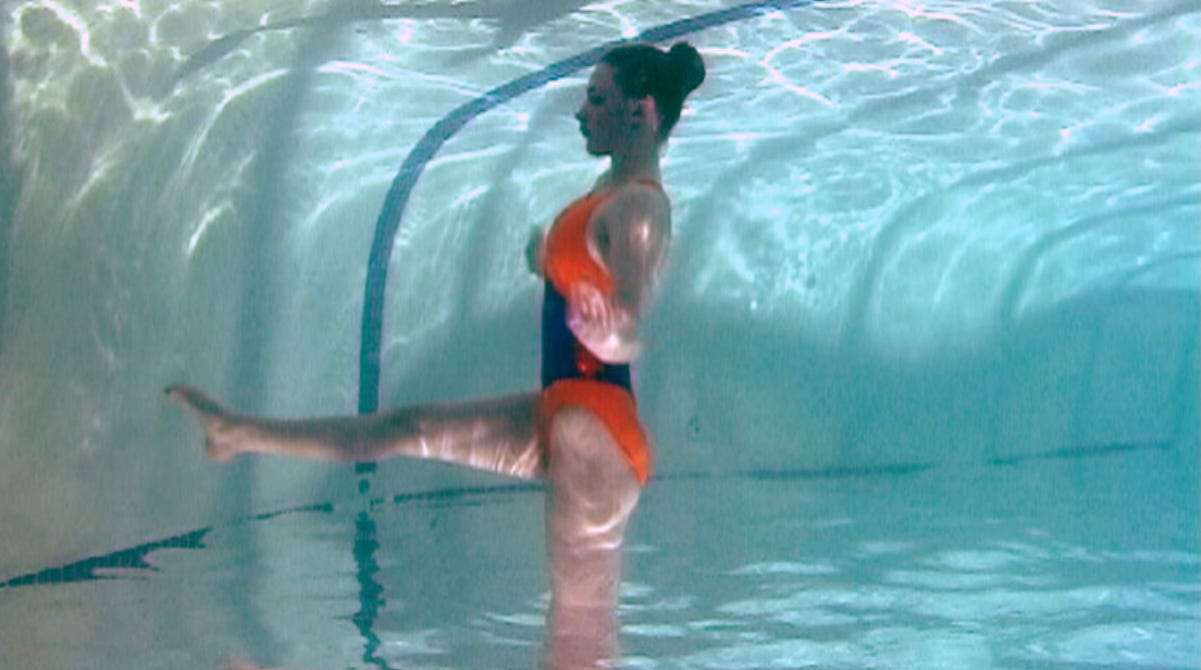
New York-based Janet Biggs (American, b. 1959) creates videos, photographs, and performances and is represented in the Grey Museum exhibition by her video Airs Above the Ground (2007), completed three years after receiving her AWAW award. A synchronized swimmer filmed underwater is presented in slow-motion and upside-down, making the viewer aware of the swimmer’s effort which is invisible to the judges and spectators who observe the stylized movements above the water.
This perspective reveals what is necessary to maintain and support those movements, and, by extension, asks the viewer to grapple with what is required to live up to society’s objectifying notions of the ease and beauty of youth. – Janet Biggs
The title comes from the sport of dressage, where horses and riders also perform stylized movements, some of which make the horses seem to float above the ground. In later projects, the artist has continued to explore the interactions of humans and their challenging environments, including in deserts, mines, and the Arctic.
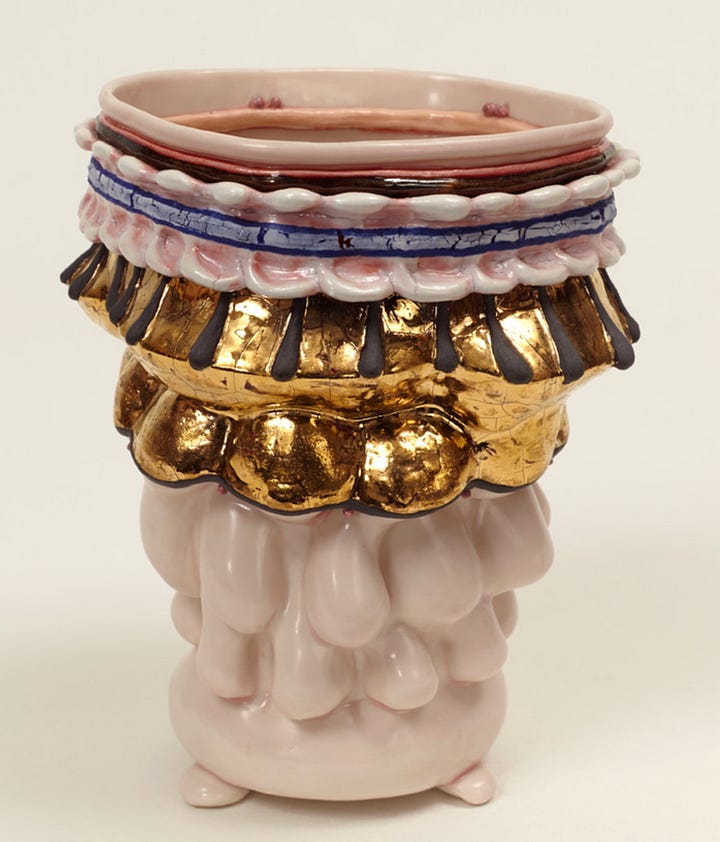
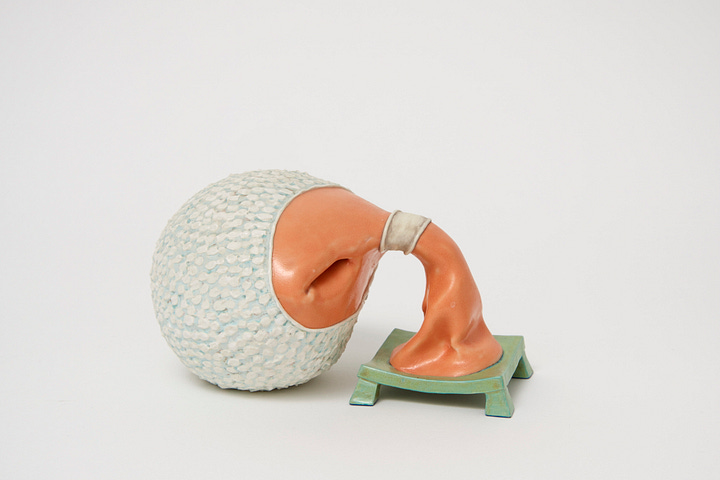
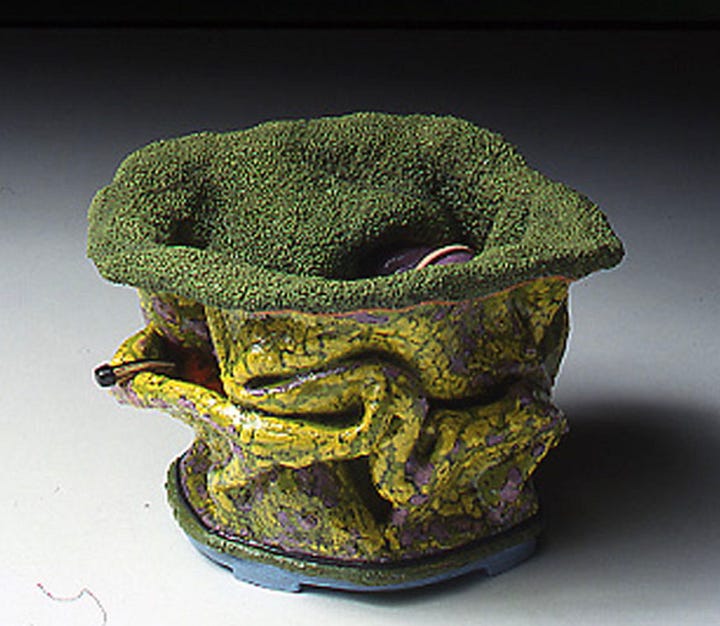
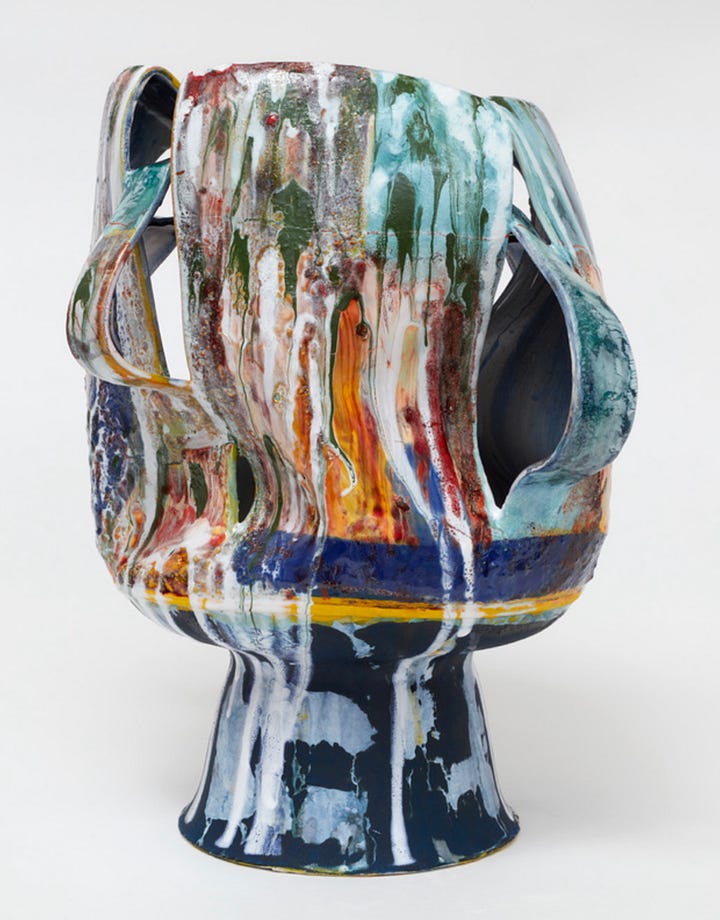
Kathy Butterly (American, b. 1963) is known for her small clay sculptures that frequently appear to have crumpled or deformed from some internal or external pressure. Of the works included in the gallery above, one (Garter, 1996) was completed before the artist received her AWAW grant. This work shows the artist’s interest in varied colors and textures created with glazes, something which is consistent throughout her career. However, it lacks the deformations that most later works have and maintains the cup-like form of the object upon which it was originally molded. Butterly begins by shaping her clay around mundane household objects and then builds onto the base form before beginning to bend and fold the objects. The next step is to add colorful and textural glazes to enhance the emotional expression of the work. Heavy Head (2003), for example, reflects the artist’s weighty fears as a new mother in the post-9/11 world. Garter and Heavy Head, along with Chinese Garden (2005), are included in the Grey Art Museum exhibition. These early works are tiny, ranging from three to six inches.
I know that they’re small pieces, but when I’m working on them, they feel like infinity to me. – Kathy Butterly
I have added a later work, Crossed Lines (2020) to demonstrate how Butterly’s experimentation with glazes has expanded over time. Her most recent sculptures are repeatedly glazed and fired, some as many as 40 times. In Crossed Lines, you can see through the drips and layers to earlier colors and textures. In spite of the heavily worked surfaces of her later works, the artist’s works remain small, with Crossed Lines barely over a foot tall.
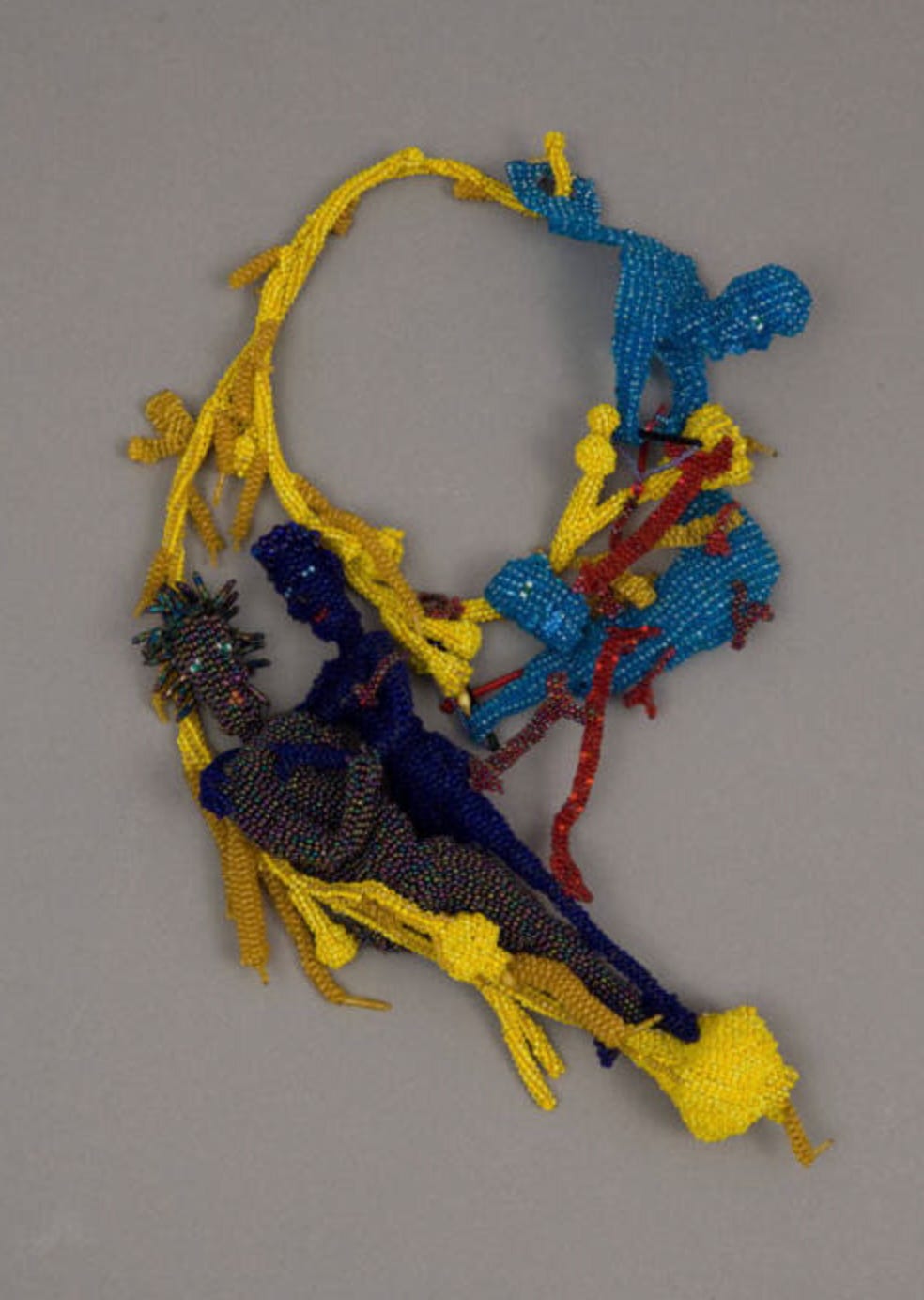
The role of traditional craft techniques in fine art has been a recurring concern among artists since the later 20th century. Women artists, especially, have worked to welcome traditionally anonymous crafts into their practice. Jill J. Scott (American, b. 1948) has utilized quilting and beading throughout her career, in addition to working as a printmaker, sculptor, and performance artist. As a child, she was taught to sew and was encouraged in her desire to become an artist by her mother, prominent quiltmaker Elizabeth Talford Scott. Lovers (2002) is an example of the artist’s use of sculptural beading for storytelling. The piece takes the form of a necklace, and the technique is informed by the artist’s knowledge of diverse beadwork techniques, including Native American, Mexican, European, and Yoruba traditions. Her imagery is also inspired by popular culture, including comic books, and other styles of illustration. Scott, who was recognized by AWAW in 1997, sees her reliance on traditional crafts as maintaining her connection to her ancestors for whom mastering multiple crafts was a means of survival.

Marie Watt (American, b. 1967) creates collaborative and individual projects centered around donated blankets. A member of the Seneca Nation, blankets are deeply symbolic for the artist, because they are often given as gifts to witnesses of important life events within Native American cultures. She also finds that blankets are familiar and literally comforting objects that are welcoming to a broad audience, inspiring thoughts of history, community, and family. Skywalker/Skyscraper (Axis Mundi) of 2012 is composed of a pile of wool blankets supported by an eight foot steel I-beam and is part of a series begun in the years after Watt received the AWAW award in 2006. The artist created these tall stacks of blankets in reference to New York’s skyscrapers, which Haudenosaunee ironworkers helped to build. The artist has described the use of “Skywalker” in the title as an “otherworldly,” “mythic,” and even a “spiritual” reference.

An artist who is known for creating works from collections of found objects, Betye Saar (American, b. 1926) was honored by AWAW in 2004. Saar’s assemblages are made up of diverse objects which have no relationship until the artist’s imagination joins them together. In Globe Trotter (2007), a birdcage containing figures sits atop a small table while an old globe rests on the lower shelf. The globe suggests that enslaved Africans were forced to become the titular “globe trotters” without the glamour that attached to the term in the 20th century.
The materials conjure ideas. The ideas conjure images. The images conjure art. The art conjures feelings. The feelings are the goal. – Betye Saar
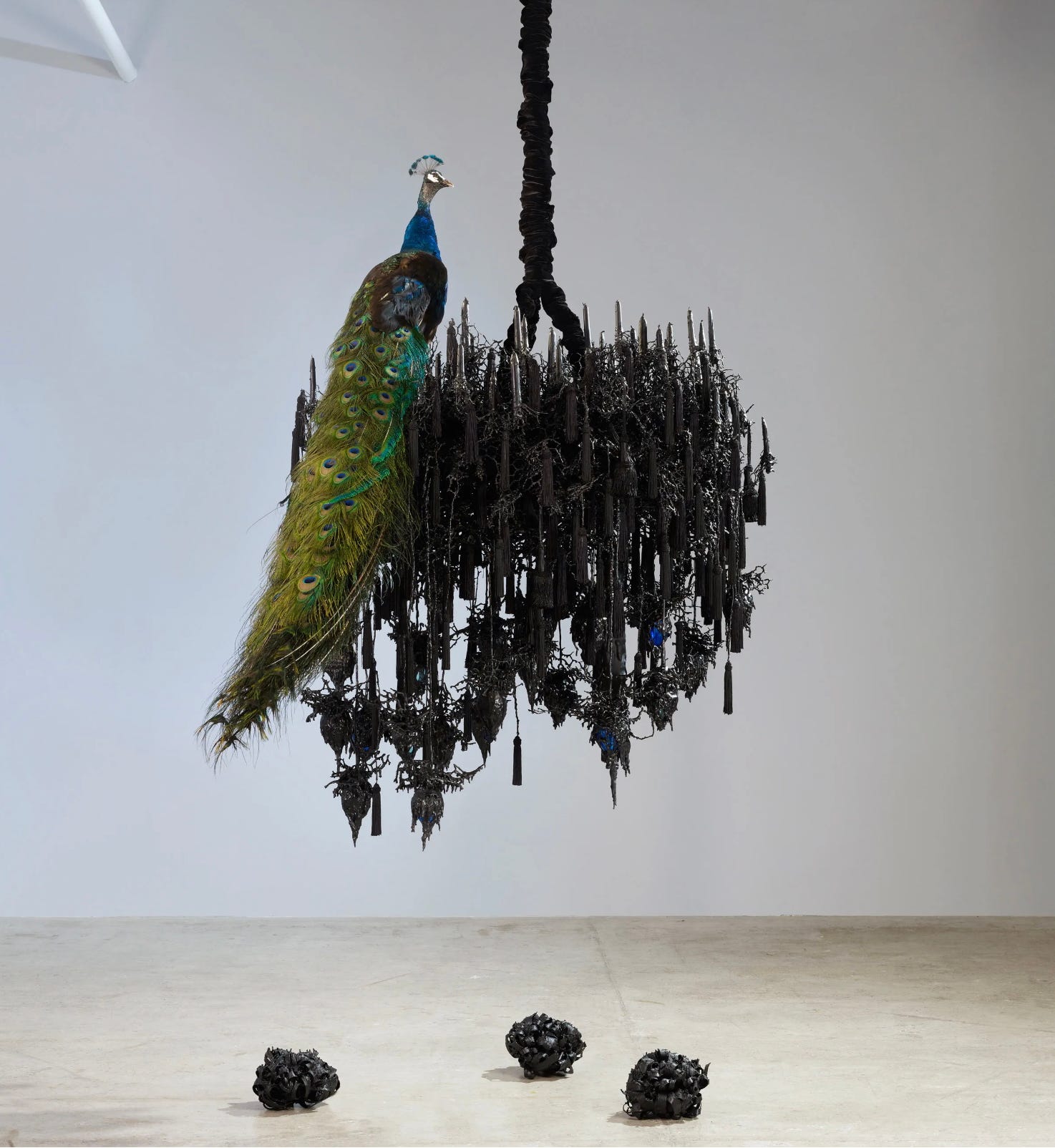
Another artist known for her assemblage-like sculptures is Petah Coyne (American, b. 1953. One must look much more closely into the densely-packed and diverse materials of Coyne’s works to determine their origins, however. The example here, Untitled #1242 (Black Snowflake), 2007-2012, contains a long list of materials, from the obvious, taxidermy peacock, to chicken wire, cable, and Velcro, and other materials lost in the blackness of the rest of the work. One of a series of chandelier-like structures and wall hangings on which the artist began work around the time of her AWAW award, this sculpture refers to the black rain which fell on Hiroshima after the atomic bombing. Still, the complex surfaces and structures of Coyne’s sculptures provide numerous opportunities for viewers to make discoveries and interpretations of their own.
A hundred and fifty years ago it was impossible, unheard of, for a woman to be a sculptor. . . . So the territory is wide open for my generation. There is so much to discover. – Petah Coyne
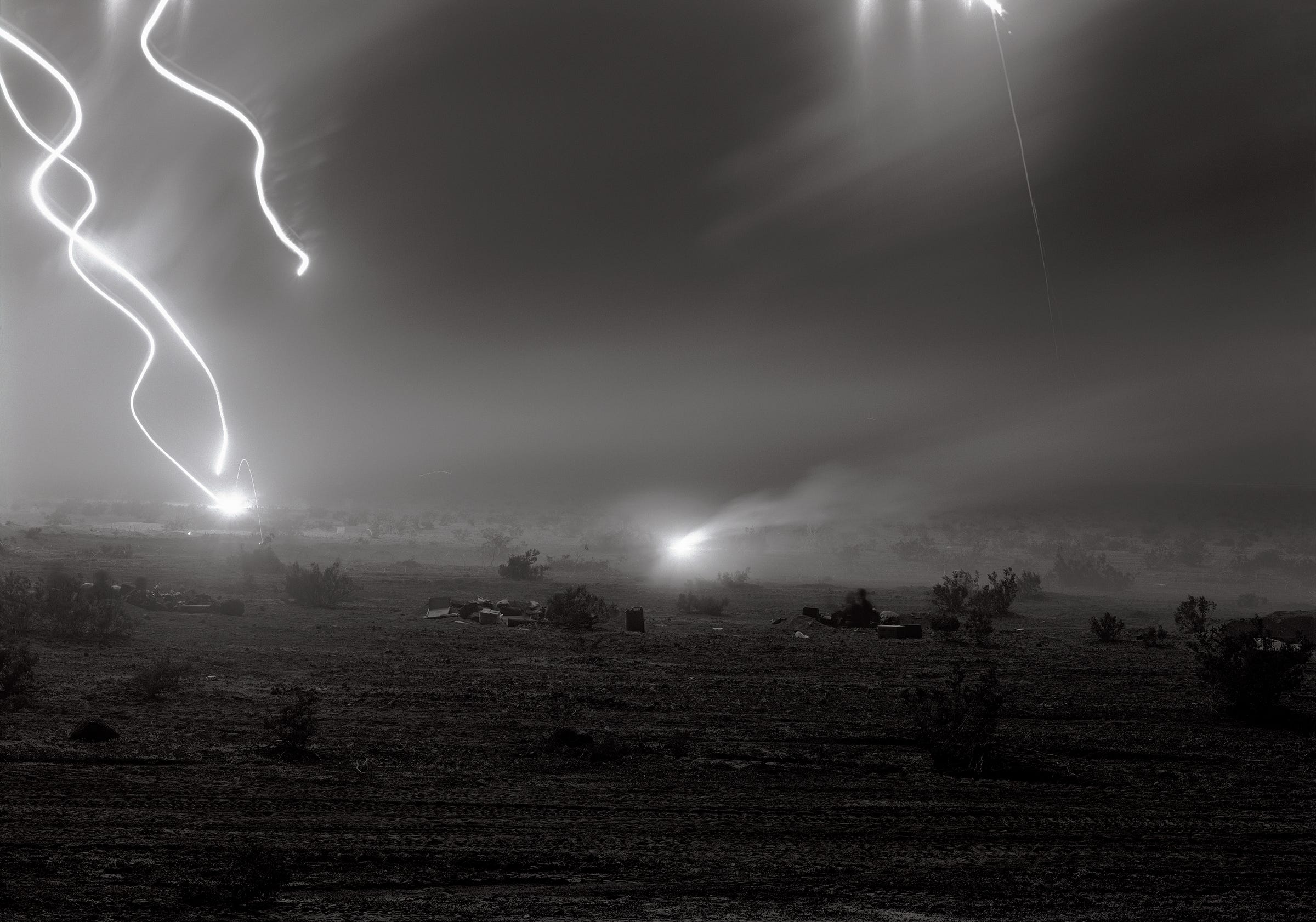
Photographer An-My Lê (Vietnamese-American, b. 1960) has spent much of her career exploring the interaction of war and landscape. This photograph from her series 29 Palms was created during live-fire military training exercises to prepare for deployment to the Middle East. Though the photographs capture a simulated war environment, the ground shook as Lê worked, intensifying her experience of events.
My main goal is to try to photograph landscape in such a way that it suggests a universal history, a personal history, a history of culture. – An-My Lê
The images lure viewers to them with their rich array of precise detail and beautiful contrasts of dark and light. It is only on closer inspection that the nature of those details becomes clear in a sometimes disturbing contradiction to aesthetic pleasure. Lê received the AWAW grant in 2006.
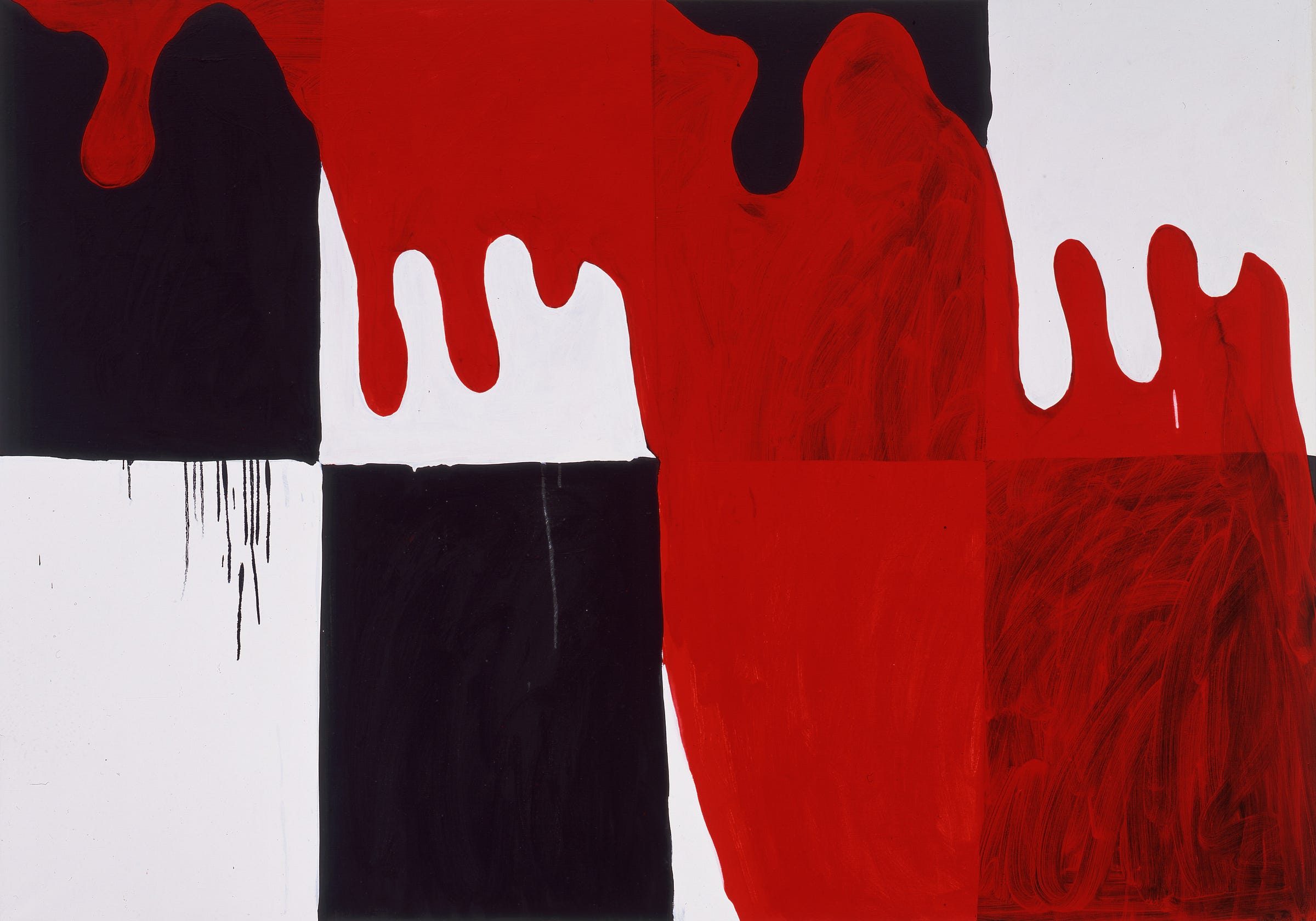
Mary Heilmann (American, b. 1940), who received her AWAW award in the same year as Lê, began her artistic career as a sculptor, but painful rejections of her work led her to switch her allegiance to painting in the early 1970s. Her early paintings were connected to geometric abstraction and Jack of Hearts, included in the Grey Art Museum’s exhibition, harks back to that period with its black and white grid design. The contrast between the background and the organic spill of semi-transparent red paint is dramatic in both color and shape.
I use the paint in a physical and sculptural way. The sides of the canvases are painted and are part of the work, so that a painting is an object as much as it is a picture. – Mary Heilmann
The painting’s title connects the work to others of similar date by Heilmann and to the black, white, and red color scheme of playing cards. Now in her 80s, the painter is regarded as an influential figure among younger painters. In addition to her inclusion in this exhibition, Heilmann is the subject of a solo exhibition at the Whitney Museum of American Art in New York (through January 19, 2026).
That concludes this brief survey of artists included in the Anonymous Was A Woman exhibition at the Grey Art Museum. If you have an opportunity to visit the exhibition, please share your experience in a comment on this post. AWAW is growing and expanding the ways in which it supports women artists. You can learn more at their website. (https://www.anonymouswasawoman.org/)
I Require Art thanks Sofeia Eddy and the Grey Museum for sharing images from and information about the exhibition.
Exhibition: Anonymous Was A Woman: The First 25 Years, Grey Museum of Art at New York University, 18 Cooper Square, New York City, 10003, through July 19, 2025. https://greyartmuseum.nyu.edu/exhibition/anonymous-was-a-woman-the-first-25-years/
As always, thank you for reading and subscribing. We welcome your comments and questions. I’ll be back in two weeks to celebrate the 250th anniversary of J. M. W. Turner’s birth.




The peacock one though is STUNNING